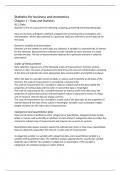Summary
Summary Statistics for Pre-MSc (EBS027A05)
- Course
- Institution
- Book
Summary of the book: Anderson, Sweeney, Williams, Camm, Cochran, Freeman, and Shoesmith (2020),Statistics for Business & Economics; Fifth Edition for the course Statistics for Pre-MSc. Chapters 1-5, 7, 8, 9.
[Show more]




